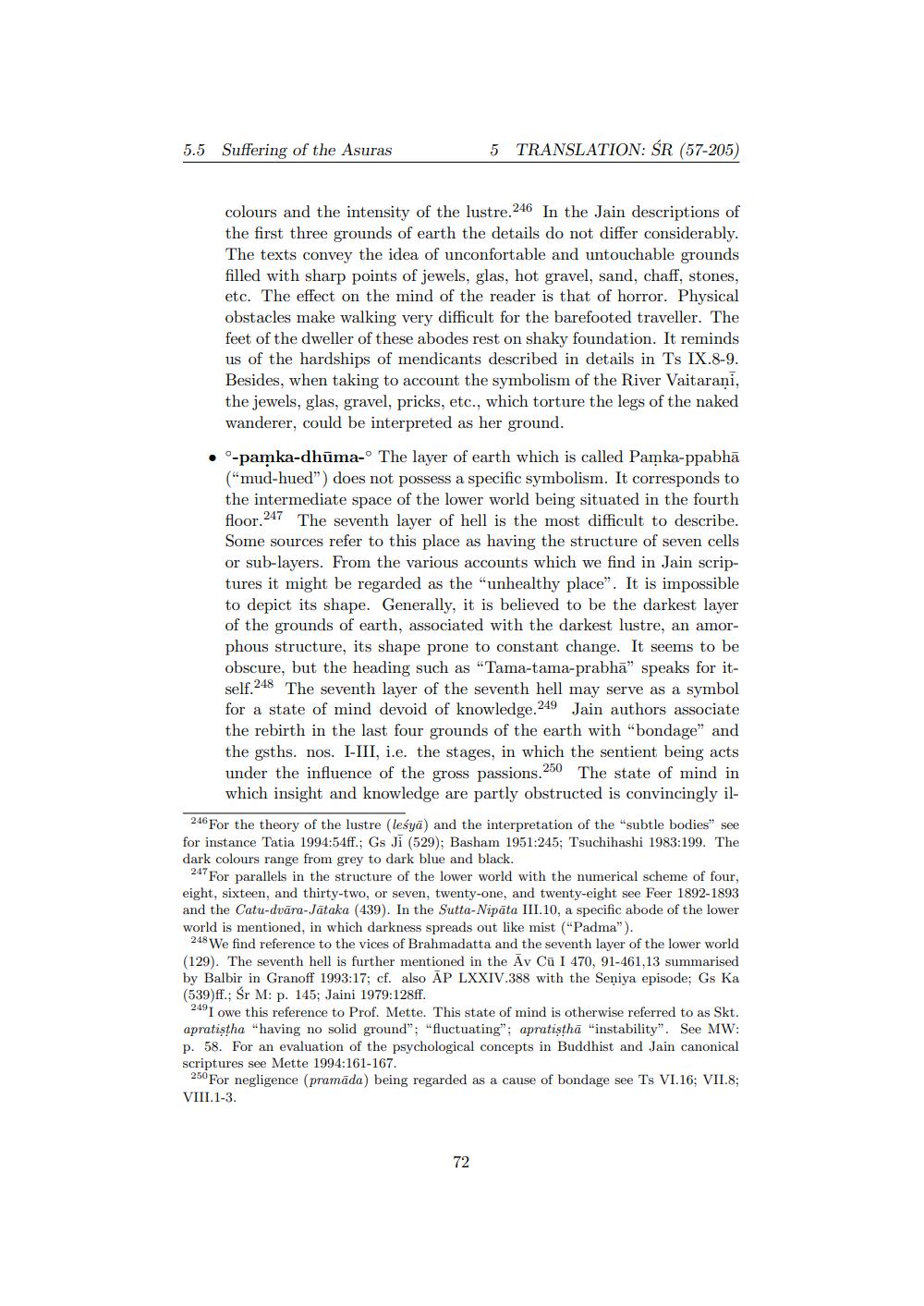________________
5.5
Suffering of the Asuras
5 TRANSLATION: ŚR (57-205)
colours and the intensity of the lustre. 246 In the Jain descriptions of the first three grounds of earth the details do not differ considerably. The texts convey the idea of unconfortable and untouchable grounds filled with sharp points of jewels, glas, hot gravel, sand, chaff, stones, etc. The effect on the mind of the reader is that of horror. Physical obstacles make walking very difficult for the barefooted traveller. The feet of the dweller of these abodes rest on shaky foundation. It reminds us of the hardships of mendicants described in details in Ts IX.8-9. Besides, when taking to account the symbolism of the River Vaitarani, the jewels, glas, gravel, pricks, etc., which torture the legs of the naked wanderer, could be interpreted as her ground.
o-pamka-dhūma-° The layer of earth which is called Pamka-ppabhā ("mud-hued") does not possess a specific symbolism. It corresponds to the intermediate space of the lower world being situated in the fourth floor.247 The seventh layer of hell is the most difficult to describe. Some sources refer to this place as having the structure of seven cells or sub-layers. From the various accounts which we find in Jain scriptures it might be regarded as the "unhealthy place". It is impossible to depict its shape. Generally, it is believed to be the darkest layer of the grounds of earth, associated with the darkest lustre, an amorphous structure, its shape prone to constant change. It seems to be obscure, but the heading such as "Tama-tama-prabhā" speaks for itself.248 The seventh layer of the seventh hell may serve as a symbol for a state of mind devoid of knowledge 249 Jain authors associate the rebirth in the last four grounds of the earth with "bondage" and the gsths. nos. I-III, i.e. the stages, in which the sentient being acts under the influence of the gross passions.250 The state of mind in which insight and knowledge are partly obstructed is convincingly il
246 For the theory of the lustre (leśyā) and the interpretation of the "subtle bodies" see for instance Tatia 1994:54ff.; Gs Ji (529); Basham 1951:245; Tsuchihashi 1983:199. The dark colours range from grey to dark blue and black.
247 For parallels in the structure of the lower world with the numerical scheme of four, eight, sixteen, and thirty-two, or seven, twenty-one, and twenty-eight see Feer 1892-1893 and the Catu-dvāra-Jätaka (439). In the Sutta-Nipāta III. 10, a specific abode of the lower world is mentioned, in which darkness spreads out like mist ("Padma").
248 We find reference to the vices of Brahmadatta and the seventh layer of the lower world (129). The seventh hell is further mentioned in the Av Cū I 470, 91-461,13 summarised by Balbir in Granoff 1993:17; cf. also AP LXXIV.388 with the Seniya episode; Gs Ka (539)ff.: Sr M: p. 145; Jaini 1979:128ff.
249 I owe this reference to Prof. Mette. This state of mind is otherwise referred to as Skt. apratistha "having no solid ground"; "fluctuating"; apratisthā "instability". See MW: p. 58. For an evaluation of the psychological concepts in Buddhist and Jain canonical scriptures see Mette 1994:161-167.
250 For negligence (pramada) being regarded as a cause of bondage see Ts VI.16; VII.8; VIII.1-3.




